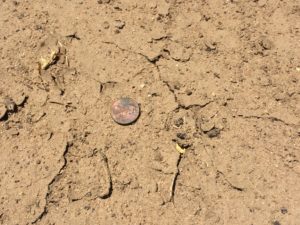Over the past few weeks, there have been several farm visits discussing water infiltration issues. In many of these cases, chemical sealing of the surface soil has occurred. This creates a crust that reduces the movement of the water into the soil. In subsequent irrigation, when water is applied faster than the rate of infiltration, puddling occurs, leading to an increase in evaporation as well as saturated soil conditions. This impacts water use efficiency and tree health.

A season of irrigation can require between 36 and 52 inches of applied water per acre. This is often applied to a limited area of an orchard, which is defined as the wetting pattern. Each irrigation system has a different wetting pattern, with micro-sprinklers somewhere around 30-60% of the orchard area, and drip around 20%. This means that, dependent on the system, the wetted area may receive 2-5 times more water than the targeted season’s application per acre. In other words, if four acre feet/acre were applied using a drip system that wets around 20% of the orchard floor, the soil in that wetting profile has nearly 20 acre feet of water that must pass through in order to infiltrate the soil. This is a tremendous volume of water to pass through the soil, and it can leach away beneficial elements which leads to chemical sealing and infiltration problems.
When infiltration rates slow, it is important to know the causes as not all infiltration issues are the same. Taking an analysis of the water and soil is a good place to start. Unlike soil sampling conducted in the fall, soil sampling of the top 2-3″ of soil should occur to identify the chemical imbalance. Analyzing the soil and water will give an idea of salt load, SAR, pH, as well as other elements. This will help identify what should be to applied to “open the soil back up.”
After the analysis is performed, a management plan can be developed. Below are a few causes and some solutions to consider:
Adjusting irrigation frequency, water source, or irrigation system. Utilizing these practices will be the cheapest and should be the starting point in developing a management strategy.
Manage and reduce the formation of soil crusts. Crusts form due to the break down of soil aggregates and dispersion of particles. Often times, a soil analysis of crusted surface soil will reveal an imbalance of cations. Generally, gypsum is used as calcium is required by the tree for a number of purposes and is generally safe for the plant. Gypsum can be applied by land grade (dormant and June) or suspended in the irrigation water (weekly or monthly). If these types of applications aren’t possible, consider using calcium containing fertilizers such as calcium nitrate, calcium ammonium nitrate, calcium thiosulfate, etc. It might be best to time the use of these in May when water applications increase and tree nitrogen demand is high. If already formed, tillage may be needed to break up the crust.
Too high of sodium. Sodium increases particle dispersion and decrease aggregate formation, reducing water infiltration. Generally, this is observed when the sodium:calcium ratio is greater than 3:1. This effect may be amplified by alkaline irrigation water, which may precipitate or “tie up” available calcium. Often, this can be identified by looking at the SAR and adjusted SAR value on the water analysis. Calcium containing amendments or water acidification can help, depending on the issue.
High, Low Soil pH. Extreme soil pH on either end of the scale can decrease aggregate formation and lead to soil sealing. Adjusting appropriately to bring as close to the 7 will help. In dealing with alkaline soils (high pH), often the water is acidified to reduce the soil pH. The pH of the water should not be dropped below 5. In low pH soils, the options are more limited and lime or other neutralizing amendments must be added.
Soil compaction. This occurs from the weight of machinery disrupting the soil’s pore space. Tilling can help reduce the impacts of compaction, but prevention is key. Avoid driving in the orchard when the soil is wet, and use lighter weight equipment when possible. Remember, its not about the total weight, but the weight per square inch of wheel contact.
There are other tools than tillage, calcium, and pH amending products. Surfactants and various polymers (such as polyacrylamide materials) can help increase infiltration rates and are useful in the process of identifying and working towards a long term solution. Cover crops increase soil aggregate formation and have been shown to improve infiltration over bare soil or spring chemical “mowing.” Biochar and regular compost applications have been shown to increase infiltration rates, but the longevity and feasibility is unknown. The effect of humic/fulvic acids is less documented, but work is currently underway.
Remember, managing infiltration issues is an ACTIVE process and needs to occur regularly. Waiting until the issue occurs and then trying to find a remedy increases the requirement of higher cost products and will impact yield. More information can be found in this chapter from the archived UC ANR Pistachio Production Manual: http://fruitsandnuts.ucdavis.edu/files/73694.pdf

